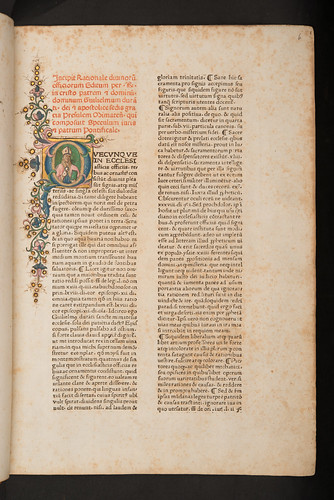Duranti, Guillelmus: Rationale divinorum officiorum.
Edited by Johannes Baptista de Lanciis.
Rome: Ulrich Han and Simon Nicolai Chardella de Lucca, 23 June 1473.
Fol. [14 2-410 58 6-710 8-98 10-1110 12-138 14-1510 168 176 18-1910 2012 21-2210 23-248 25-2610 278 286 29-3010 318 326]. [284] leaves (2/1, 32/6 blank).
ISTC id00406000; GW 9104; Goff D406; BMC IV 23 (IC. 17290); Bod-inc D-193; CIBN D-280.
| GIP number: | D32 |
| Shelf-mark: | Sp Coll Hunterian Bg.1.6 (see main library entry for this item) |
| Note: | 9/3-6 (ff. 73-76) misbound between 7/5 and 7/6 (ff. 57 and 58) so that quire 7 appears to be of 14 leaves and quire 9 of 4 leaves. |
| Provenance: | Franciscus Tibaldus (17th/18th century): printed book label “Ex libris Ad. R.P. Magistri Francisci Tibaldi. T.” on lower margin of 1/2r. Edward Harley (1689-1741), Lord Harley; from 1724 2nd Earl of Oxford: see below. Thomas Osborne (d. 1767), bookseller: purchased all the Harleian printed books; top corner of first front flyleaf cut off - as in many other Harleian volumes - probably by Osborne to remove his earlier price (cf. J.B. Oldham, Shrewsbury School bindings, p. 114); revised price in pencil “2=10=0” adjacent to excision; no. 1360 in Osborne’s Catalogus bibliothecae Harleianae, vol. 3 (London: 1744) and no. 1901 in his Catalogus bibliothecae Harleianae, vol. 5 (London: 1745). William Hunter (1718-1783), physician and anatomist: source unknown. University of Glasgow: Hunterian bequest 1807; Hunterian Museum book-plate on front pastedown, with former shelfmark “Ad.4.7”. |
| Binding: | England, 18th-century gold-tooled red goatskin, bound for Lord Harley by Thomas Elliott. On both covers triple fillets form two concentric frames: within the outer frame is an ornamental roll (Nixon ‘Harleian bindings’, pl. 14, Elliott roll 4), and within the inner frame is a flower head and fleur-de-lys roll (Nixon, ‘Harleian bindings’, pl. 14, Elliott roll 1), together with an ornamental roll not illustrated by Nixon. Both covers are decorated with a lozenge-shaped centre-piece, made up of several individual tools including Nixon, ‘Harleian bindings’, pl. 15, Elliott nos 2, 13, 16a, and 16b. The head and tail of the spine are decorated with a smaller version of Nixon, ‘Harleian bindings’, pl. 14, Elliott roll 2, and the spine compartments are decorated with several individual tools including Nixon, ‘Harleian bindings’, pl. 15, Elliott nos 3a, 3b, 16a, and 16b. The edges and turn-ins are decorated with a smaller version of Elliott roll 2; marbled endpapers; parchment guard-strips in the middle of each quire. Size: 397 x 280 mm. |
| Leaf size: | 384 x 268 mm. |
| Annotations: | Very occasional marginal annotations and manicules in a 16th-century hand; foliated in an early hand from 2/2 (f. 6) onwards. |
| Decoration: | A six-line historiated initial “Q” in two shades of blue, set on a gold square ground and framing a portrait of Guillelmus Duranti holding a book, is supplied on 2/2r (f. 6r), and from the initial there extends into the inner margin a floral border in pink, blue, green and gold (the initial is considered to be in the style of Francesco d’Antonio del Cherico of Florence - see N.R. Thorp, The glory of the page, no. 91); other initials throughout supplied in alternate red and blue (occasionally with reserved white). |
| Imperfections: | Wanting 32/5 (f. 283) i. e. the Registrum and the blank leaf 32/6; the blank outer half of 32/4 (f. 282) has been excised and the inner half containing the colophon has been mounted on a blank sheet of paper. |





